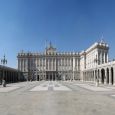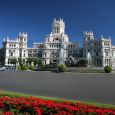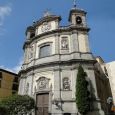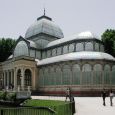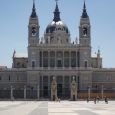Madrid
Advertisement
By plane
Madrid Barajas International Airport (IATA: MAD), 902 404 704, is located 13km from the Puerta del Sol. It has 4 terminals, including a new low-cost carrier terminal that opened in 2006. Terminal 4 has won architectural awards, and might be worth the trip to have a look even if you are not flying.
The airport is connected to the city by Metro line 8, to get to Sol you will have to take Line 8 to the last stop and then transfer to line 10 going southbound to Tribunal and then Line 1 to Sol. Metro tickets to/from the airport cost €2. A Express Bus Service for 2 euros reaches O'Donell, Cibeles and Atocha
By train
Renfe operates train service to/from Madrid. Frequent trains operate between Madrid and Barcelona (2h 40min), Seville (2h 20 min), Malaga (2h 30 min), Zaragoza, Tarragona, Lerida, Huesca, Ciudad Real, Puertollano, Lisbon, Milan, the French coast, Paris, with continuing journeys to most of Europe.
Northbound trains arrive and depart from Chamartín station, while trains to Barcelona, Valencia and southern Spain depart from Atocha railway station.
By bus
Madrid has eight enormous international and intercity bus stations. Information on where buses to a particular destination depart from can be found at the Tourist Office.
Many of the international buses, and those headed south of Madrid, arrive at and depart from Estación Sur de Autobuses which is accessible by metro.
Buses to and from Barcelona and Bilbao operate from the Avenida de América bus terminal, also accessible by Metro.
By car
There are car rental facilities available at the airport, train stations, and other main travel sites. Always be sure to have a street map handy! The roads within Madrid are difficult to navigate as there are no places to stop and consult a map or check your route.Also, if you are relying on GPS navigation, be aware that there are several consecutive junctions underground near the centre and your GPS may not get a signal underground. Plan your turns before you enter the tunnels.
Advertisement
Plaza Mayor
The Plaza Mayor was built during the Habsburg period and is a central plaza in the city of Madrid, Spain. It is located only a few blocks away from another famous plaza, the Puerta del Sol. The Plaza Mayor is rectangular in shape, measuring 129 by 94 metres, and is surrounded by three-storey residential buildings having 237 balconies facing the Plaza. It has a total of nine entranceways. The Casa de la Panadería, serving municipal and cultural functions, dominates the Plaza Mayor.
Plaza de Cibeles
The Plaza de Cibeles is a square with a neo-classical complex of marble sculptures with fountains that has become an iconic symbol for the city of Madrid.The fountain of Cibeles is found in the part of Madrid commonly called the Paseo de Recoletos. This fountain, named after Cybele (or Ceres), Roman goddess of nature, is seen as one of Madrid's most important symbols. The Cibeles fountain depicts the goddess, sitting on a chariot pulled by two lions. The fountain was built in the reign of Charles III and designed by Ventura Rodríguez between 1777 and 1782. The goddess and chariot are the work of Francisco Gutiérrez and the lions by Roberto Michel. The fountain originally stood next to the Buenavista Palace, and was moved to its present location in the middle of the square in the late 19th century. Up until the 19th century both the fountain of Neptune and Cibeles looked directly at each other, until the city council decided to turn them round to face towards the centre of the city.
Temple of Debod
The Templo de Debod or Temple of Debod is an ancient Egyptian temple which was rebuilt in Madrid, Spain.The temple was built originally 15 km south of Aswan[1] in southern Egypt very close to the first cataract of the Nile and to the great religious center dedicated to the goddess Isis, in Philae. In the early 2nd century BC, Adikhalamani (Tabriqo), the Kushite king of Meroë, started its construction by building a small single room chapel dedicated to the god Amun. It was built and decorated on a similar design to the later Meroitic chapel on which the Temple of Dakka is based. Later, during the reigns of Ptolemy VI, Ptolemy VIII and Ptolemy XII of the Ptolemaic dynasty, it was extended on all four sides to form a small temple, 12 X 15 m, which was dedicated to Isis of Philae. The Roman emperors Augustus and Tiberius completed its decorations
Almudena Cathedral
Santa María la Real de La Almudena is a Catholic cathedral in Madrid.When the capital of Spain was transferred from Toledo to Madrid in 1561, the seat of the Church in Spain remained in Toledo; so the new capital – unusually for a Catholic country – had no cathedral. Plans were discussed as early as the 16th century to build a cathedral in Madrid dedicated to the Virgin of Almudena, but construction did not begin until 1879.
Royal Palace of Madrid
The Palacio Real de Madrid is the official residence of the King of Spain in the city of Madrid, but it is only used for state ceremonies. King Juan Carlos and the Royal Family do not reside in the palace, choosing instead the more modest Palacio de la Zarzuela on the outskirts of Madrid. The palace is owned by the Spanish State and administered by the Patrimonio Nacional, a public agency of the Ministry of the Presidency. The palace is located on Calle de Bailén (Bailén Street), in the Western part of downtown Madrid, East of the Manzanares River, and is accessible from the Ópera metro station. The palace is partially open to public, except when it is being used for official business.
St. Michael's Basilica
The Pontifical Basilica of St. Michael is a baroque Roman Catholic church and minor basilica in central Madrid, Spain. It is located in San Justo Street, adjacent to the Archbishop's Palace. It is the church of the Apostolic Nunciature to the Kingdom of Spain of the Holy See is now administrated by the Opus Dei.
Convent of the Salesas Reales
The Convent of the Salesas Reales is a 18th century architectural complex in central Madrid, Spain. Formerly a convent, specifically the Convent of the Visitación de Nuestra Señora (Visitation of Our Lady), it was constructed and occupied by the Order of the Visitation of Holy Mary, which had been founded by St. Francis de Sales and Jane Frances de Chantal. While the Santa Barbara temple is still in use, now as a parish church, the remainder of the complex now houses the Supreme Court of Spain.
Palacio de Cristal
Palacio de Cristal, "Crystal Palace" is a glass palace located in Madrid's Buen Retiro Park. It was built in 1887 to exhibit flora and fauna from the Philippines. It is 22 m (72 ft) high and is currently used for art exhibits
August - November
Information not available
Advertisement

